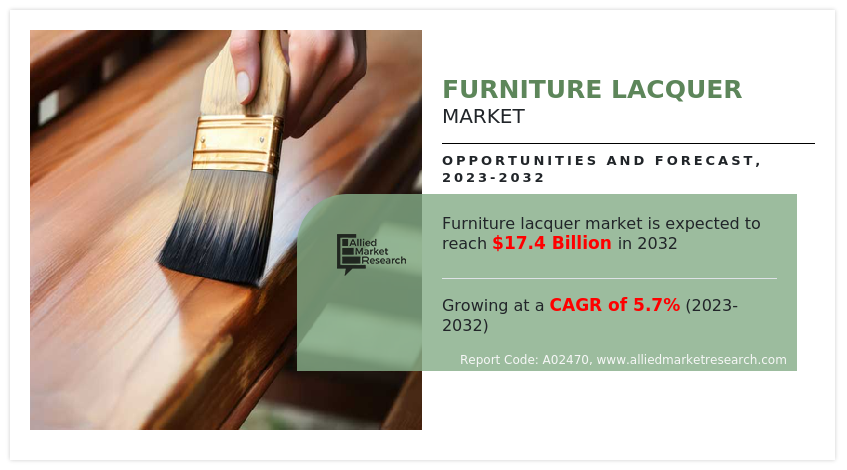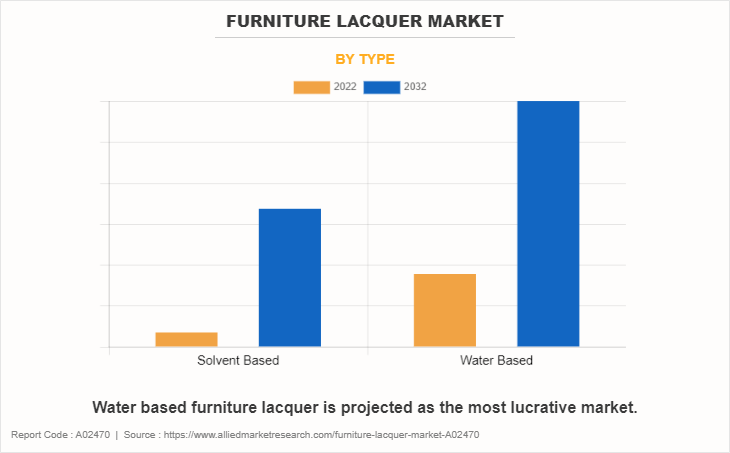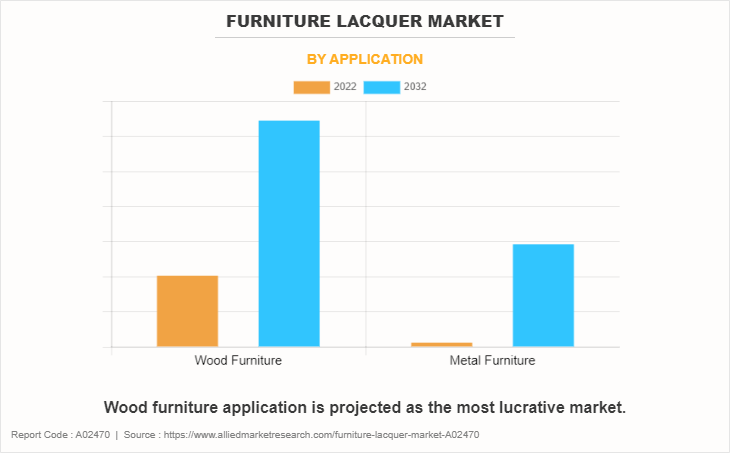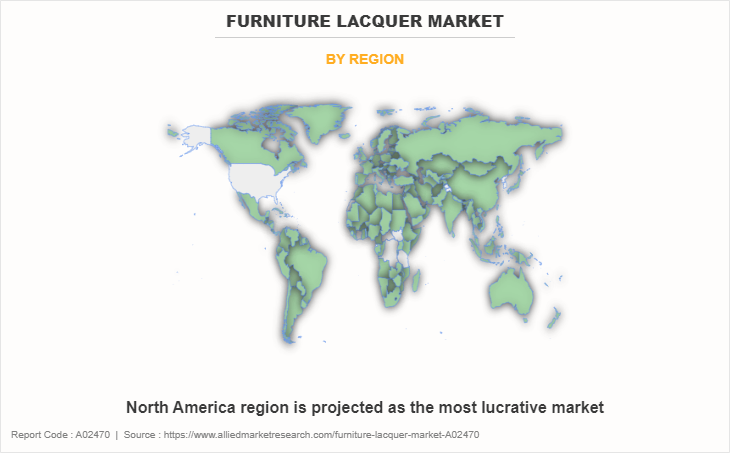Furniture Lacquer Market Research, 2032
The global furniture lacquer market was valued at $10.1 billion in 2022, and is projected to reach $17.4 billion by 2032, growing at a CAGR of 5.7% from 2023 to 2032.
Report Key Highlighters:
- The furniture lacquer market has been analyzed in value. The value of the furniture lacquer market is analyzed in millions.
- Global Furniture lacquer market is fragmented in nature with many players such as Akzo Nobel N.V., PPG Industries, Inc., Nippon Paint Holdings Co., Ltd., The Sherwin-Williams Company, Diamond Paints, Minwax, Rust-Oleum, Morrells Woodfinishes Ltd, M.L. Campbell and Axalta Coating Systems. Also tracked key strategies such as product launches, acquisitions, mergers, expansion etc. of various manufacturers of Furniture lacquer.
- Included more than 20 countries in the report which covers market volume as well as market value for all the countries of the Furniture lacquer market.
- Covered the detailed list of manufacturers by application of the furniture lacquer market. It covers the product information, application, and geographical presence of the companies.
- Conducted primary interviews with raw material suppliers, wholesalers, suppliers, and manufacturers of the Furniture lacquer market to understand the market trends, furniture lacquer market growth factors, pricing, and key players competitive strategies, Furniture lacquer market forecast.

Furniture lacquer is a type of finish that is applied to wooden furniture to enhance its appearance and protect the surface. Lacquer is a clear or colored coating that dries to a hard and durable finish. It is commonly used in furniture manufacturing and refinishing due to its ability to provide a smooth and glossy surface. Lacquer can be applied through various methods, including spraying, brushing, or wiping, depending on the specific type of lacquer and the desired finish. The application of lacquer creates a protective layer on the furniture, helping to guard against scratches, moisture, and general wear and tear.
There are different types of lacquer, such as nitrocellulose lacquer, acrylic lacquer, and catalyzed lacquer, each with its own characteristics and uses. Nitrocellulose lacquer, for example, is known for its quick-drying properties and traditional use in vintage furniture. Acrylic lacquer is water-based and tends to be more environment-friendly. Catalyzed lacquer contains a catalyst that accelerates the curing process, resulting in a harder and more durable finish. Furniture lacquer is favored for its ability to provide a high-gloss, smooth, and durable finish, enhancing the natural beauty of the wood while offering protection against everyday wear and tear.
Furniture lacquer offers a protective layer that helps prevent damage from scratches, moisture, and general wear and tear. Lacquer becomes a popular choice for its ability to provide such protection as consumers prioritize durability and longevity in their furniture purchases. Furthermore, furniture lacquer offers a protective layer that helps prevent damage from scratches, moisture, and general wear and tear. Lacquer becomes a popular choice for its ability to provide such protection as consumers prioritize durability and longevity in their furniture purchases.
The globalization of the furniture industry means that manufacturers can access a broader market. Furniture lacquer, being a versatile and widely applicable finish, becomes a key component in meeting the diverse preferences of consumers across the globe. Moreover, the growth of e-commerce has made it easier for consumers to access a variety of furniture options. Online retailers often showcase furniture with attractive finishes, and the visual appeal of lacquer-finished furniture is expected to attract buyers. The growth of the furniture lacquer market is projected to be a result of a combination of these factors, reflecting evolving consumer preferences, economic conditions, and advancements in the industry.
Increased Demand For Building Renovation And Remodeling:
The increased demand for building renovation and remodeling activities can indeed contribute to the expansion of the global furniture lacquer market. There is a parallel demand for new and updated furniture as more individuals and businesses invest in renovating and remodeling their homes or commercial spaces. Furniture lacquer, with its ability to provide a fresh and polished finish, becomes an attractive choice for those looking to enhance the appearance of existing furniture or incorporate new pieces into renovated spaces. Renovation projects often focus on improving the overall aesthetics of a space. Furniture lacquer offers a glossy and smooth finish that can significantly contribute to the visual appeal of furniture. This is particularly important when trying to achieve a modern or updated look in a renovated space.
In addition, some renovation projects, there is a desire to preserve and restore existing furniture pieces. Furniture lacquer can be used to refresh and protect the surfaces of older furniture, extending their lifespan and maintaining their aesthetic appeal. Renovation projects may be driven by a desire to align spaces with modern design trends. Furniture lacquer allows for customization in terms of color and sheen, making it a versatile option to achieve contemporary design aesthetics.
Furthermore, the trend of upcycling and repurposing furniture has gained popularity. Furniture lacquer plays a role in refinishing and transforming old or outdated furniture into stylish, contemporary pieces that fit the renovated space. Moreover, renovation activities in commercial spaces, such as hotels, restaurants, and offices, often involve updating furniture to meet change in design standards. The demand for furniture lacquer may be significant in these sectors to achieve a polished and professional look.
The furniture lacquer market is expected to benefit from increased opportunities to provide finishes that meet the evolving needs of consumers and the design industry as the demand for building renovation and remodeling activities continues to grow.
The furniture lacquer market is segmented into type, application, and region. On the basis of type, the market is bifurcated into solvent-based and water-based. On the basis of application, the market is bifurcated into wood furniture and metal furniture. On the basis of region, the market is studied across North America, Europe, Asia-Pacific, and LAMEA.
The major players operating in the industry include Akzo Nobel N.V., PPG Industries, Inc., Nippon Paint Holdings Co., Ltd., The Sherwin-Williams Company, Diamond Paints, Minwax, Rust-Oleum, Morrells Woodfinishes Ltd, M.L. Campbell and Axalta Coating Systems. These players have adopted product launch as their key strategy to increase their market shares.

On the basis of type, the market is bifurcated into water-based and solvent-based. In 2022, the water-based type was the largest revenue generator of the furniture lacquer market. Water-based lacquers are generally considered more environment-friendly compared to solvent-based alternatives. They often have lower volatile organic compound (VOC) emissions, contributing to a healthier indoor environment and aligning with the increasing focus on sustainable and eco-friendly products.

On the basis of application, the global furniture lacquer market is fragmented into wood furniture and metal furniture. Wood furniture was the largest revenue generator, in 2022 and is anticipated to expand at a CAGR of 6% during the forecast period as wood is a popular material for furniture due to its natural beauty and warm aesthetics. Furniture lacquer enhances the visual appeal of wood by providing a glossy and smooth finish, showcasing the natural grain and color variations.

On the basis of region, the furniture lacquer market is analyzed across North America, Europe, Asia-Pacific, and LAMEA. The Asia-Pacific furniture lacquer market size is projected to expand at the highest CAGR of 6.1% during the forecast period as the rise in disposable income in many Asia-Pacific countries has resulted in change in lifestyles and an increased focus on home aesthetics. Consumers are willing to invest in high-quality furniture with attractive finishes, including lacquer.
Key Benefits For Stakeholders
- This report provides a quantitative analysis of the market segments, current trends, estimations, and dynamics of the furniture lacquer market analysis from 2022 to 2032 to identify the prevailing furniture lacquer market opportunities.
- The market research is offered along with information related to key drivers, restraints, and opportunities.
- Porter's five forces analysis highlights the potency of buyers and suppliers to enable stakeholders make profit-oriented business decisions and strengthen their supplier-buyer network.
- In-depth analysis of the furniture lacquer market segmentation assists to determine the prevailing market opportunities.
- Major countries in each region are mapped according to their revenue contribution to the global market.
- Market player positioning facilitates benchmarking and provides a clear understanding of the present position of the market players.
- The report includes the analysis of the regional as well as global furniture lacquer market trends, key players, market segments, application areas, and market growth strategies.
Furniture Lacquer Market Report Highlights
| Aspects | Details |
| Market Size By 2032 | USD 17.4 billion |
| Growth Rate | CAGR of 5.7% |
| Forecast period | 2022 - 2032 |
| Report Pages | 248 |
| By Type |
|
| By Application |
|
| By Region |
|
| Key Market Players | Morrells Woodfinishes Ltd, PPG Industries, Inc., Axalta Coating Systems, The Sherwin-Williams Company, Nippon Paint Holdings Co., Ltd., Diamond Paints, Rust-Oleum, Akzo Nobel N.V., MLCAMPBELL, Minwax |
Analyst Review
According to CXOs, the growth of the furniture industry, driven by factors such as urbanization, rise in disposable income, and changing lifestyles, contributes to increased demand for finishes like lacquer. Consumers often prefer furniture with durable and visually appealing coatings. Furthermore, increased renovation and remodeling activities in both residential and commercial spaces drive the demand for lacquer finishes. Consumers and businesses may choose to refresh or update existing surfaces with lacquer for a modern and polished look. These factors are expected to drive market growth during the forecast period.
However, fluctuations in the prices of raw materials, such as wood, metal, foam, and fabrics, impacts production costs for furniture manufacturers. Sudden increases in material prices may lead to higher production expenses and, in turn, affect pricing and profitability. This may hinder market growth during the forecast period.
The global furniture lacquer market was valued at $1o.1 billion in 2022 and is projected to reach $17.4 billion by 2032, expanding at a CAGR of 5.7% from 2023 to 2032.
The Asia-Pacific furniture lacquer market size is projected to expand at the highest CAGR of 6.1% during the forecast period as the rise in disposable income in many Asia-Pacific countries has resulted in change in lifestyles and an increased focus on home aesthetics. Consumers are willing to invest in high-quality furniture with attractive finishes, including lacquer.
. Wood furniture was the largest revenue generator, in 2022 and is anticipated to expand at a CAGR of 6% during the forecast period as wood is a popular material for furniture due to its natural beauty and warm aesthetics. Furniture lacquer enhances the visual appeal of wood by providing a glossy and smooth finish, showcasing the natural grain and color variations.
Upcoming trends in the global Furniture Lacquer Market include a growing preference for water-based and eco-friendly formulations, increased demand for customizable finishes, and innovative application methods. Sustainability and health-conscious consumer choices are driving the market towards greener solutions, shaping the future landscape of furniture lacquer products.
The major players operating in the industry include Akzo Nobel N.V., PPG Industries, Inc., Nippon Paint Holdings Co., Ltd., The Sherwin-Williams Company, Diamond Paints, Minwax, Rust-Oleum, Morrells Woodfinishes Ltd, M.L. Campbell and Axalta Coating Systems.
The key driver of the furniture lacquer market is its ability to enhance the durability and aesthetic appeal of furniture. As consumers seek long-lasting and visually appealing products, the demand for furniture lacquer, which provides protective coatings and customizable finishes, continues to grow, driving the market forward.
The key opportunity for the furniture lacquer market lies in technological advancements, particularly the development of eco-friendly formulations. As sustainability becomes a significant consumer concern, manufacturers have the opportunity to innovate and offer environmentally conscious lacquer options, meeting the growing demand for green and socially responsible products in the market.
Loading Table Of Content...
Loading Research Methodology...



